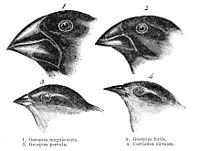
Photo from wikipedia
While much excitement has attended the discovery and study of circular RNAs, a new study in Cell Reports suggests that most mammalian circRNAs are not only functionless, but in fact costly.… Click to show full abstract
While much excitement has attended the discovery and study of circular RNAs, a new study in Cell Reports suggests that most mammalian circRNAs are not only functionless, but in fact costly. Comparison across three species is also consistent with the influential but rarely tested Drift-Barrier Hypothesis of molecular complexity. According to this hypothesis, nonessential genomic elements are slightly deleterious elements that fix by genetic drift and, thus, are generally more abundant in species with small effective population sizes. I discuss the implications of these new results for the Drift-Barrier hypothesis. In particular, I note the distinction between two classes of genomic elements, based on whether they are created by 'standard' small-scale mutations (basepair substitutions, indels, etc.) or larger, more idiosyncratic mutations (segmental duplications, transposable element propagation, etc.) I suggest that the Drift-Barrier Hypothesis is likely to apply to the former class, but perhaps not the latter class.
Journal Title: Journal of molecular evolution
Year Published: 2021
Link to full text (if available)
Share on Social Media: Sign Up to like & get
recommendations!